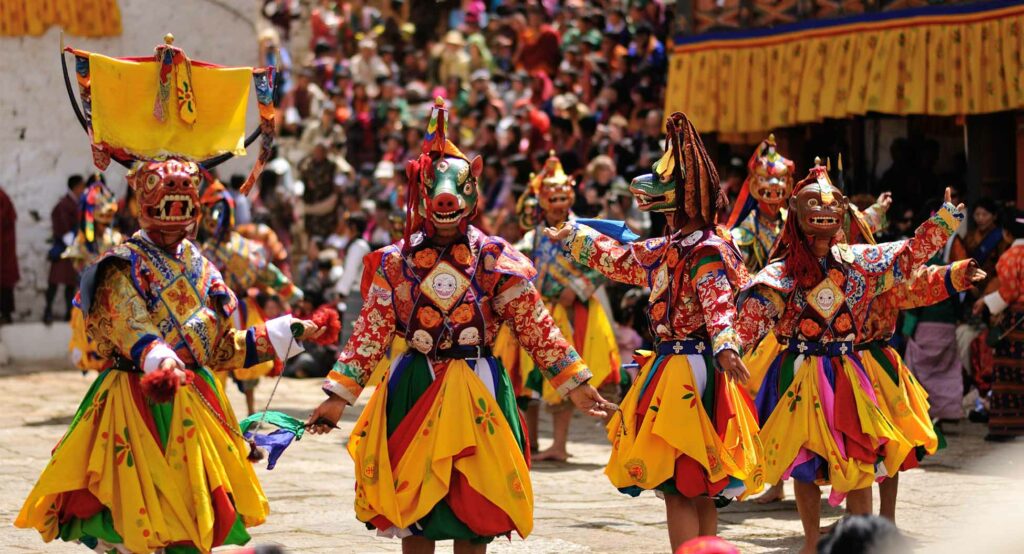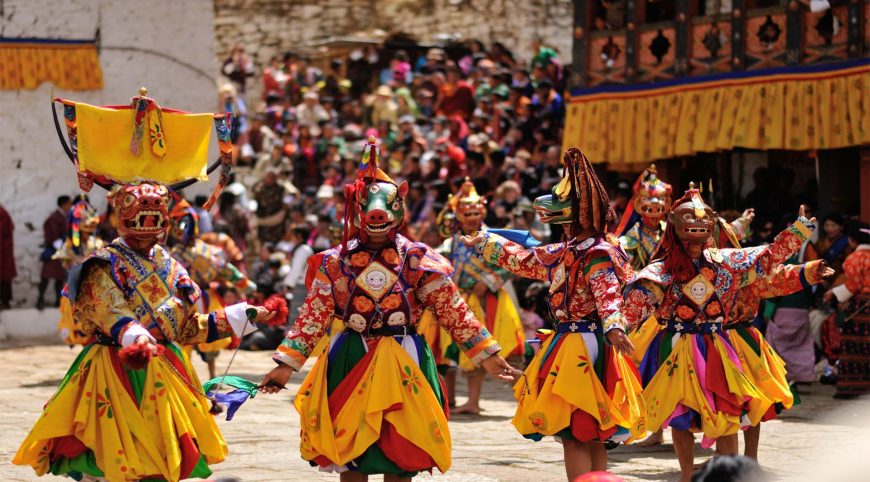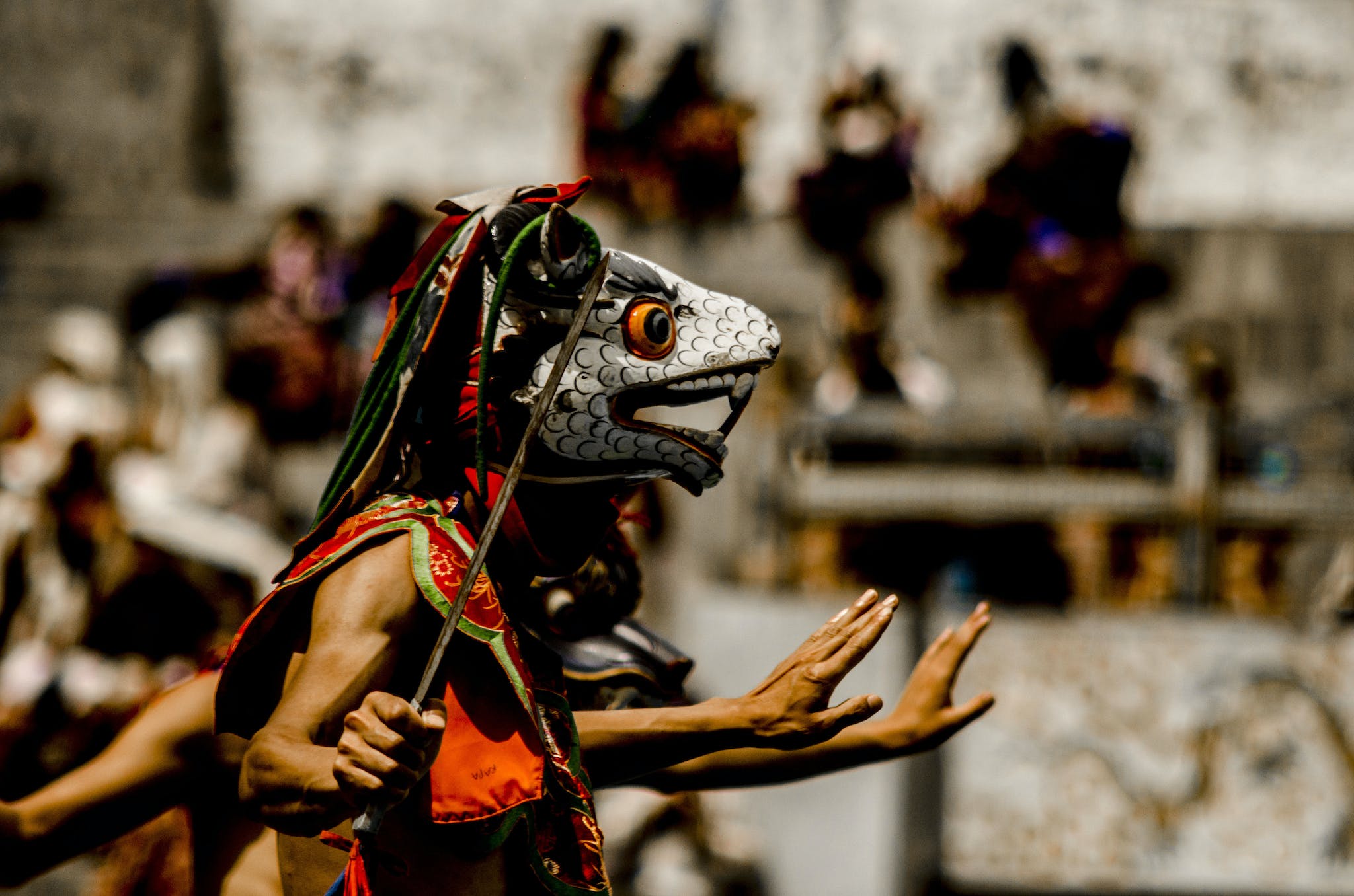Gemlike Bhutan, tucked away in the Eastern Himalayas, is known not merely for its stunning natural scenery but also for its rich cultural richness. At Xplore Bhutan, we have a strong belief that the Tsechus, or festivals, of Bhutan are where the country's true spirit can be found beating. Travellers will get a deeper understanding of the culture, music, and dancing of this mysterious realm by attending one of these festivals, which serve as a window into the kingdom's very essence.
1. Paro Tshechu

Nestled in the heart of the Eastern Himalayas, Bhutan's Paro Tshechu Festival stands as a testament to the nation's unique vision of Gross National Happiness. Initiated by the 4th king of Bhutan, Jigme Singye Wangchuck, in the 1970s, this vision prioritized the well-being of the Bhutanese people over materialistic gains. Today, the Paro Tshechu Festival is a vibrant expression of this philosophy, attracting thousands of visitors each year.
The Paro Tshechu Festival is celebrated every March, marking the blossoming of trees and magnolias. Originally a consecration ceremony for the Dzong Paro Rinpung in the mid-17th century, it has evolved into an annual event honoring Guru Rinpoche, the "Lotus-Born Teacher" who introduced Tantric Buddhism to the Himalayas in the 8th century. Over five consecutive days, the sacred activities of the Guru are re-enacted through dance, folksongs, and music, offering both locals and tourists a deep spiritual connection.
A significant highlight of the festival is the Thongdrol, an enormous embroidered thangka depicting Guru Rinpoche and his various manifestations. Unveiled only once a year during the Paro Tshechu, devotees from all over Bhutan gather in the early morning hours to receive blessings from this sacred fabric, believed to liberate them from sin and evil.
The festival also features a series of ritual dances with evocative titles such as "Dance of the Lords of Cremation Grounds" and "Dance of the Terrifying Deities." These dances, performed in colorful outfits, masks, and headdresses, depict the various manifestations of Guru Rinpoche as he introduced Buddhism to the region. The festival is further enlivened by the presence of atsaras, jesters who entertain the crowd with their witty antics, reminding attendees of the importance of humor on the path to enlightenment.
2. Thimphu Tshechu

Thimphu Tshechu is an annual religious Bhutanese festival held in the capital city of Thimphu. Celebrated for three days, starting from the 10th day of the 8th month of the lunar calendar, it's one of the grandest of Bhutan's festivals and attracts the largest audience. The festival is a display of the rich culture of Bhutan and its deeply spiritual traditions.
The Tshechu was first initiated by the 4th Desi, Gyalse Tenzin Rabgay in 1867. It had only a few dances being performed and was later elaborated by the third King of Bhutan, Jigme Dorji Wangchuck, in 1950. The festival is a religious event celebrated on the tenth day of a month of the lunar calendar, corresponding to the birthday of Guru Rimpoche (Guru Padmasambhava). However, the exact month of the Tshechu varies from one district to another.
During the Thimphu Tshechu, several traditional dances are performed. These dances include the Zhana chham and the Zhana Nga chham (Dances of the 21 Black Hats), Durdag (Dance of the Lords of Cremation Ground), and Drametse Nga chham (Dance of the Drums from Drametse). One of the major attractions of the Thimphu Tshechu is the unfurling of the thongdrel (a giant religious banner) which is displayed for the public to receive blessings.
The festival is also a social gathering where the Bhutanese people, dressed in their finest traditional clothes, come together to rejoice and celebrate. It's an occasion for dancing, singing, and feasting.
The Thimphu Tshechu, like all Tshechus, is not just an event for entertainment but also serves as a deeply spiritual occasion. Bhutanese believe that by attending a Tshechu, they can cleanse their sins and receive blessings. Each dance has a special significance and story behind it, often depicting tales from as far back as the 8th century.
3. Punakha Drubchen

The Punakha Drubchen is a unique festival held in the Punakha district of Bhutan. Unlike other traditional festivals that are mostly religious in nature, the Punakha Drubchen stands out as it commemorates the victory of Bhutan over Tibetan invaders in the 17th century. This significant event in Bhutanese history is reenacted during the festival, showcasing the spirited and vibrant battle scenes.
The festival is a tribute to the Bhutanese leader, Zhabdrung Ngawang Namgyal, who not only introduced the dual system of governance but also played a pivotal role in repelling the Tibetan forces. The reenactment of the battle scenes is not just a mere performance; it's a reminder of the sacrifices made by the Bhutanese ancestors and their unwavering spirit to defend their homeland.
Held in the beautiful Punakha Dzong, also known as "The Palace of Great Happiness," the festival is a blend of history and spirituality. The Dzong itself has a rich history, being the second oldest and second-largest dzong in Bhutan. Its picturesque location at the confluence of the Pho Chhu and Mo Chhu rivers adds to the grandeur of the festival.
The Punakha Drubchen also serves as a prelude to the Punakha Tshechu, another significant festival that follows immediately after. While the Drubchen focuses on the historical reenactment, the Tshechu is more religious, with mask dances and other traditional performances.
4. Black Necked Crane Festival

The Black Necked Crane Festival is a unique celebration held in the picturesque Phobjikha Valley of Bhutan. This festival is not just an event but a harmonious blend of Bhutanese culture and nature. Organized annually, the primary aim of the festival is to raise awareness about the importance of conserving the endangered Black Necked Cranes. These majestic birds, known for their elegant black necks, migrate to the Phobjikha Valley during the winter months from the Tibetan plateau.
The festival is celebrated at the Gangtey Monastery, a 17th-century structure that overlooks the vast expanse of the Phobjikha Valley. The main event of the festival includes a series of cultural programs, folk songs, and dances. Some of these performances are themed around the Black Necked Cranes, symbolizing their significance in the Bhutanese culture. Additionally, mask dances performed by the locals and crane dances add vibrancy to the festival.
Initiated in 1998, the Black Necked Crane Festival has become an integral part of the local culture in Phobjikha Valley. It serves as a platform for the locals to showcase their traditions, beliefs, and commitment to nature conservation. The festival also attracts numerous tourists, offering them a chance to immerse themselves in Bhutan's rich cultural heritage and witness the mesmerizing dance of the Black Necked Cranes in their natural habitat.
5. Jambay Lhakhang Drup

The Jambay Lhakhang Drup is a prominent festival in Bhutan, celebrated with profound reverence and vibrant festivities. It holds a dual significance in Bhutanese culture, serving as a tribute to Guru Rimpoche, who introduced the Tantric form of Buddhism to Bhutan, and commemorating the establishment of the Jambay Lhakhang temple in the 7th century. The festival is a spectacle of traditional and mask dances, each bearing profound meanings, and is known for the fire ceremony ‘Mewang’ and the religious dance ‘Tercham’. The festival also features a variety of other activities including a famous drum beat dance and a clown dance called Dola Pangtoy Shazam, and Raksha Mangcham, symbolizing life after death. The festival is not just a spiritual congregation but also a social event where locals adorn their finest clothes and partake in the festivities with packed lunches, and where local businesses set up stalls selling crafts, jewelry, religious artifacts, and Thangka. The festival serves as a medium to impart moral instructions, drive away evil spirits, and celebrate the Buddhist faith in its diverse forms. The festival is not just a visual treat but a holistic experience, offering insights into the rich cultural tapestry and spiritual ethos of Bhutan.

